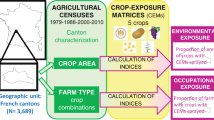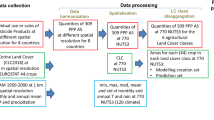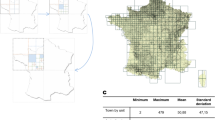Abstract
We evaluate the use of three different exposure metrics to estimate maternal agricultural pesticide exposure during pregnancy. Using a geographic information system-based method of pesticide exposure estimation, we combine data on crop density and specific pesticide application amounts/dates to create the three exposure metrics. For illustration purposes, we create each metric for a North Carolina cohort of pregnant women, 2003–2005, and analyze the risk of congenital anomaly development with a focus on metric comparisons. Based on the results, and the need to balance data collection efforts/computational efficiency with accuracy, the metric which estimates total chemical exposure using application dates based on crop-specific earliest planting and latest harvesting information is preferred. Benefits and drawbacks of each metric are discussed and recommendations for extending the analysis to other states are provided.
This is a preview of subscription content, access via your institution
Access options
Subscribe to this journal
Receive 6 print issues and online access
$259.00 per year
only $43.17 per issue
Buy this article
- Purchase on Springer Link
- Instant access to full article PDF
Prices may be subject to local taxes which are calculated during checkout


Similar content being viewed by others
References
Bell EM, Hertz-Picciotto I, Beaumont JJ . A case-control study of pesticides and fetal death due to congenital anomalies. Epidemiology 2001; 12: 148–156.
Shaw GM, Wasserman CR, O'Malley CD, Nelson V, Jackson RJ . Maternal pesticide exposure from multiple sources and selected congenital anomalies. Epidemiology 1999; 10: 60–66.
Blatter BM, Roeleveld N, Zielhuis GA, Gabreels FJM, Verbeek ALM . Maternal occupational exposure during pregnancy and the risk of spina bifida. Occup Environ Med 1996; 53: 80–86.
Garry VF, Schreinemachers D, Harkins ME, Griffith J . Pesticide appliers, biocides, and birth defects in rural Minnesota. Environ Health Perspect 1996; 104: 394–399.
Garry VF, Harkins ME, Erickson LL, Long-Simpson LK, Holland SE, Burroughs BL . Birth defects, season of conception, and sex of children born to pesticide applicators living in the Red River Valley of Minnesota, USA. Environ Health Perspect 2002; 110: 441–449.
Kristensen P, Irgens LM, Andersen A, Bye AS, Sundheim L . Birth defects among offspring of Norwegian farmers, 1967-1991. Epidemiology 1997; 8: 537–544.
Regidor E, Ronda E, Garcia AM, Dominguez V . Paternal exposure to agricultural pesticides and cause specific fetal death. Occup Environ Med 2004; 61: 334–339.
Rocheleau CM, Romitti PA, Sanderson WT, Sun L, Lawson CC, Waters MA et al. Maternal occupational pesticide exposure and risk of hypospadias in the National Birth Defects Prevention Study. Birth Defects Res A Clin Mol Teratol 2011; 91: 927–936.
Weidner IS, Moller H, Jensen TK, Skakkebaek NE . Cryptorchidism and hypospadias in sons of gardeners and farmers. Environ Health Perspect 1998; 106: 793–796.
Nelson CJ, Holson JF, Green HG, Gaylor D . Retrospective study of the relationship between agricultural use of 2,4,5-T and cleft palate occurrence in Arkansas. Teratology 1979; 19: 377–383.
Schreinemachers DM . Birth malformations and other adverse perinatal outcomes in four U.S. wheat-producing states. Environ Health Perspect 2003; 111: 1259–1264.
Gunier RB, Ward MH, Airola M, Bell EM, Colt J, Nishioka M et al. Determinants of agricultural pesticide concentrations in carpet dust. Environ Health Perspect 2011; 119: 970–976.
Meyer KJ, Reif JS, Rao Veeramachaneni DN, Luben TJ, Mosley BS, Nuckols JR . Agricultural pesticide use and hypospadias in eastern Arkansas. Environ Health Perspect 2006; 114: 1589–1595.
Brody JG, Vorhees DJ, Melly SJ, Swedis SR, Drivas PJ, Rudel RA . Using GIS and historical records to reconstruct residential exposure to large-scale pesticide application. J Expo Anal Environ Epidemiol 2002; 12: 64–80.
Royster MO, Hilborn ED, Barr D, Carty CL, Rhoney S, Walsh D . A pilot study of global positioning system/geographical information system measurement of residential proximity to agricultural fields and urinary organophosphate metabolite concentrations in toddlers. J Expo Anal Environ Epidemiol 2002; 12: 433–440.
Ward MH, Nuckols JR, Weigel SJ, Maxwell SK, Cantor KP, Miller RS . Identifying populations potentially exposed to agricultural pesticides using remote sensing and a geographic information system. Environ Health Perspect 2000; 108: 5–12.
CropScape—Cropland Data Layer [Internet]. 2012 [cited 2 October 2012]. Available from nassgeodata.gmu.edu/CropScape/.
NASS Pest Management [Internet]. 2012 [cited 2 October 2012]. Available from http://www.pestmanagement.info/nass/index.html.
North Carolina Pest Management Information Program (NCPMIP)—Crop Profiles [Internet]. 2012 [cited 2 October 2012]. Available from http://ipm.ncsu.edu/ncpmip/cropprofiles.htm.
North Carolina Crops—Usual Planting & Harvesting Dates [Internet]. 2012 [cited 2 October 2012]. Available from http://www.ncagr.gov/stats/crops/Dates.pdf.
United States Department of Agriculture (USDA) Agricultural Research Service—Pesticide Properties Database [Internet]. 2012 [cited 2 October 2012]. Available from http://www.ars.usda.gov/Services/docs.htm?docid=14199.
Xiang H, Nuckols JR, Stallones L . A geographic information assessment of birth weight and crop production patterns around mother’s residence. Environ Res 2000; 82: 160–167.
Akaike H . Information Theory and an Extension of the Maximum Likelihood Principle. In: Petrov BN, Czaki F, (Eds.). 2nd International Symposium on Information Theory. Akademiai Kiado: Budapest, Hungary. 1973, 267–281.
Nuckols JR, Langlois P, Lynberg ML, Luben T . Linking geographic water utility data with study participant residences from the National Birth Defects Prevention Study. American Water Works Association Research Foundation: Denver, CO, USA. 2004.
Chen L, Bell EM, Caton AR, Druschel CM, Lin S . Residential mobility during pregnancy and the potential for ambient air pollution exposure misclassification. Environ Res 2010; 110: 162–168.
Acknowledgements
We thank Andrew Olshan, Professor of Epidemiology and Department Chair at UNC Chapel Hill, Kristy J. Michie, Supervising Public Health Epidemiologist at the Monterey County Health Department, and Leon S. Warren Jr., Agricultural Research Associate in the North Carolina State University Department of Crop Science for providing helpful input regarding the metric creation process and general pesticide/crop timing information. This research was supported in part by grants from the National Institute of Environmental Health Sciences (T32ES007018, P30ES010126).
Disclaimer
The views expressed in this paper are those of the authors and do not necessarily reflect the views or policies of the US Environmental Protection Agency.
Author information
Authors and Affiliations
Corresponding author
Ethics declarations
Competing interests
The authors declare no conflict of interest.
Additional information
Supplementary Information accompanies the paper on the Journal of Exposure Science and Environmental Epidemiology website
Supplementary information
Rights and permissions
About this article
Cite this article
Warren, J., Luben, T., Sanders, A. et al. An evaluation of metrics for assessing maternal exposure to agricultural pesticides. J Expo Sci Environ Epidemiol 24, 497–503 (2014). https://doi.org/10.1038/jes.2013.75
Received:
Accepted:
Published:
Issue Date:
DOI: https://doi.org/10.1038/jes.2013.75
Keywords
This article is cited by
-
Evaluating the accuracy of satellite-based methods to estimate residential proximity to agricultural crops
Journal of Exposure Science & Environmental Epidemiology (2022)
-
Pesticide exposure assessed through agricultural crop proximity and risk of amyotrophic lateral sclerosis
Environmental Health (2017)



